brake sensor VOLVO XC90 TWIN ENGINE 2019 User Guide
[x] Cancel search | Manufacturer: VOLVO, Model Year: 2019, Model line: XC90 TWIN ENGINE, Model: VOLVO XC90 TWIN ENGINE 2019Pages: 697, PDF Size: 10.33 MB
Page 319 of 697
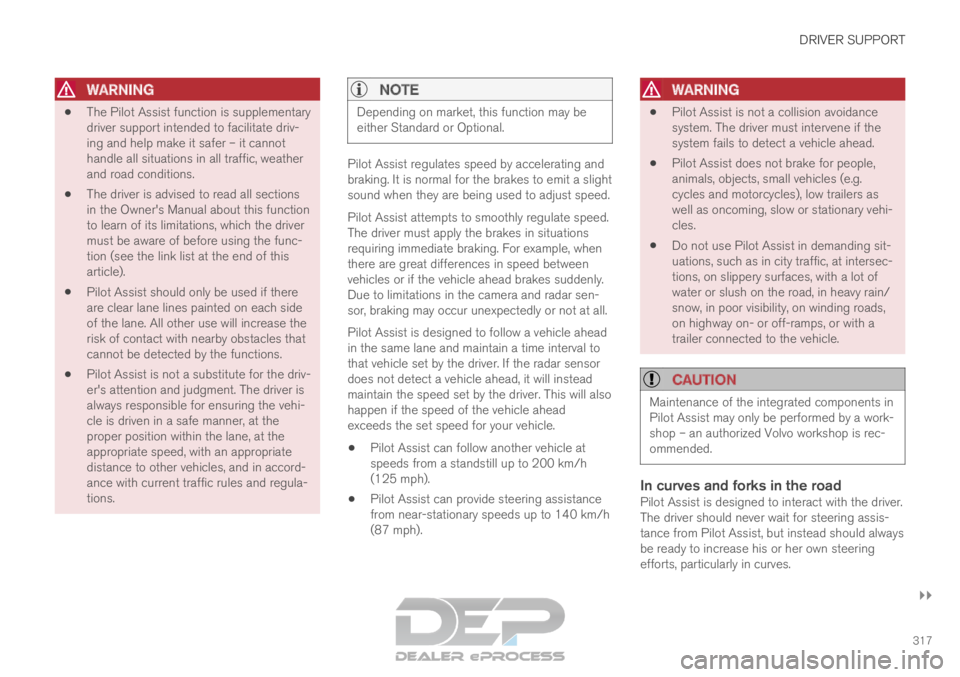
DRIVER SUPPORT
}}
317
WARNING
The Pilot Assist function is supplementary
driver support intended to facilitate driv-
ing and help make it safer – it cannot
handle all situations in all traffic, weather
and road conditions.
The driver is advised to read all sections
in the Owner's Manual about this function
to learn of its limitations, which the driver
must be aware of before using the func-
tion (see the link list at the end of this
article).
Pilot Assist should only be used if there
are clear lane lines painted on each side
of the lane. All other use will increase the
risk of contact with nearby obstacles that
cannot be detected by the functions.
Pilot Assist is not a substitute for the driv-
er's attention and judgment. The driver is
always responsible for ensuring the vehi-
cle is driven in a safe manner, at the
proper position within the lane, at the
appropriate speed, with an appropriate
distance to other vehicles, and in accord-
ance with current traffic rules and regula-
tions.NOTE Depending on market, this function may be
either Standard or Optional.
Pilot Assist regulates speed by accelerating and
braking. It is normal for the brakes to emit a slight
sound when they are being used to adjust speed.
Pilot Assist attempts to smoothly regulate speed.
The driver must apply the brakes in situations
requiring immediate braking. For example, when
there are great differences in speed between
vehicles or if the vehicle ahead brakes suddenly.
Due to limitations in the camera and radar sen-
sor, braking may occur unexpectedly or not at all.
Pilot Assist is designed to follow a vehicle ahead
in the same lane and maintain a time interval to
that vehicle set by the driver. If the radar sensor
does not detect a vehicle ahead, it will instead
maintain the speed set by the driver. This will also
happen if the speed of the vehicle ahead
exceeds the set speed for your vehicle.
Pilot Assist can follow another vehicle at
speeds from a standstill up to 200 km/h
(125 mph).
Pilot Assist can provide steering assistance
from near-stationary speeds up to 140 km/h
(87 mph).WARNING
Pilot Assist is not a collision avoidance
system. The driver must intervene if the
system fails to detect a vehicle ahead.
Pilot Assist does not brake for people,
animals, objects, small vehicles (e.g.
cycles and motorcycles), low trailers as
well as oncoming, slow or stationary vehi-
cles.
Do not use Pilot Assist in demanding sit-
uations, such as in city traffic, at intersec-
tions, on slippery surfaces, with a lot of
water or slush on the road, in heavy rain/
snow, in poor visibility, on winding roads,
on highway on- or off-ramps, or with a
trailer connected to the vehicle.
CAUTION Maintenance of the integrated components in
Pilot Assist may only be performed by a work-
shop – an authorized Volvo workshop is rec-
ommended.
In curves and forks in the roadPilot Assist is designed to interact with the driver.
The driver should never wait for steering assis-
tance from Pilot Assist, but instead should always
be ready to increase his or her own steering
efforts, particularly in curves.
Page 321 of 697
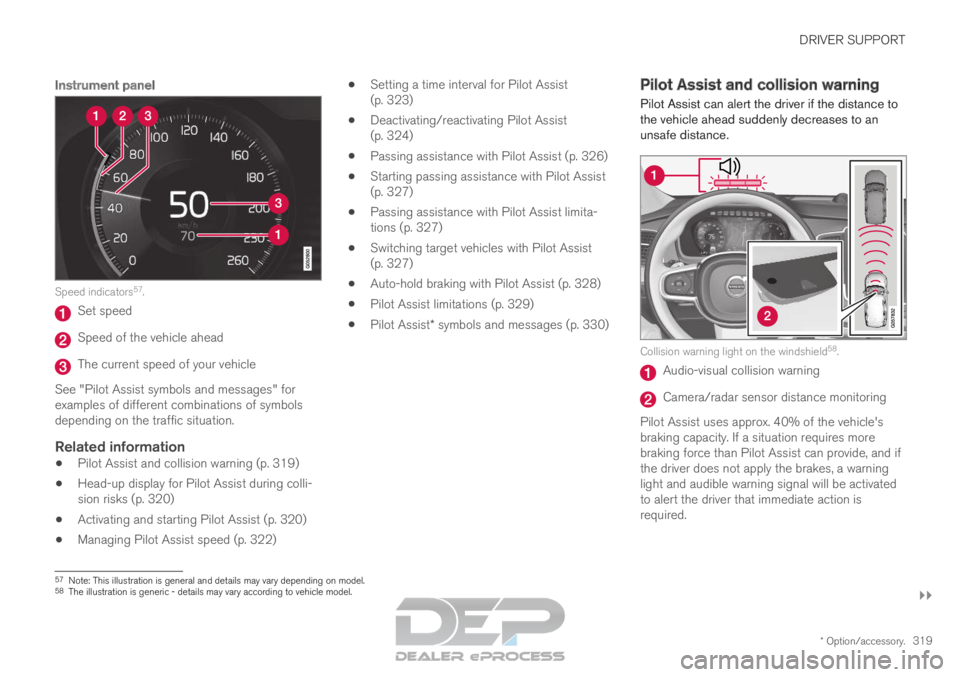
DRIVER SUPPORT
}}
* Option/accessory. 319
Instrument panelSpeed indicators
57
. Set speed
Speed of the vehicle ahead
The current speed of your vehicle
See "Pilot Assist symbols and messages" for
examples of different combinations of symbols
depending on the traffic situation.
Related information
Pilot Assist and collision warning (p. 319)
Head-up display for Pilot Assist during colli-
sion risks (p. 320)
Activating and starting Pilot Assist (p. 320)
Managing Pilot Assist speed (p. 322)
Setting a time interval for Pilot Assist
(p. 323)
Deactivating/reactivating Pilot Assist
(p. 324)
Passing assistance with Pilot Assist (p. 326)
Starting passing assistance with Pilot Assist
(p. 327)
Passing assistance with Pilot Assist limita-
tions (p. 327)
Switching target vehicles with Pilot Assist
(p. 327)
Auto-hold braking with Pilot Assist (p. 328)
Pilot Assist limitations (p. 329)
Pilot Assist* symbols and messages (p. 330) Pilot Assist and collision warning
Pilot Assist can alert the driver if the distance to
the vehicle ahead suddenly decreases to an
unsafe distance. Collision warning light on the windshield
58
. Audio-visual collision warning
Camera/radar sensor distance monitoring
Pilot Assist uses approx. 40% of the vehicle's
braking capacity. If a situation requires more
braking force than Pilot Assist can provide, and if
the driver does not apply the brakes, a warning
light and audible warning signal will be activated
to alert the driver that immediate action is
required. 57
Note: This illustration is general and details may vary depending on mod\
el.
58 The illustration is generic - details may vary according to vehicle mode\
l.
Page 327 of 697
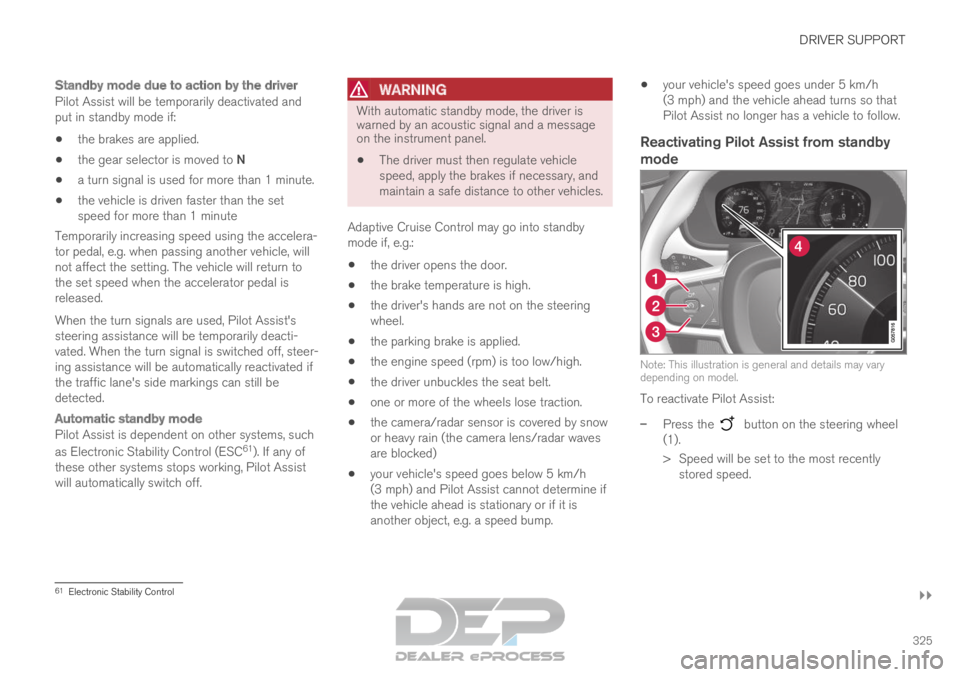
DRIVER SUPPORT
}}
325
Standby mode due to action by the driver
Pilot Assist will be temporarily deactivated and
put in standby mode if: the brakes are applied.
the gear selector is moved to N
a turn signal is used for more than 1 minute.
the vehicle is driven faster than the set
speed for more than 1 minute
Temporarily increasing speed using the accelera-
tor pedal, e.g. when passing another vehicle, will
not affect the setting. The vehicle will return to
the set speed when the accelerator pedal is
released.
When the turn signals are used, Pilot Assist's
steering assistance will be temporarily deacti-
vated. When the turn signal is switched off, steer-
ing assistance will be automatically reactivated if
the traffic lane's side markings can still be
detected.
Automatic standby mode
Pilot Assist is dependent on other systems, such
as Electronic Stability Control (ESC 61
). If any of
these other systems stops working, Pilot Assist
will automatically switch off.
WARNING With automatic standby mode, the driver is
warned by an acoustic signal and a message
on the instrument panel.
The driver must then regulate vehicle
speed, apply the brakes if necessary, and
maintain a safe distance to other vehicles.
Adaptive Cruise Control may go into standby
mode if, e.g.:
the driver opens the door.
the brake temperature is high.
the driver's hands are not on the steering
wheel.
the parking brake is applied.
the engine speed (rpm) is too low/high.
the driver unbuckles the seat belt.
one or more of the wheels lose traction.
the camera/radar sensor is covered by snow
or heavy rain (the camera lens/radar waves
are blocked)
your vehicle's speed goes below 5 km/h
(3 mph) and Pilot Assist cannot determine if
the vehicle ahead is stationary or if it is
another object, e.g. a speed bump.
your vehicle's speed goes under 5 km/h
(3 mph) and the vehicle ahead turns so that
Pilot Assist no longer has a vehicle to follow.
Reactivating Pilot Assist from standby
mode Note: This illustration is general and details may vary
depending on model.
To reactivate Pilot Assist:
–
Press the button on the steering wheel
(1).
>
Speed will be set to the most recently
stored speed. 61
Electronic Stability Control
Page 332 of 697
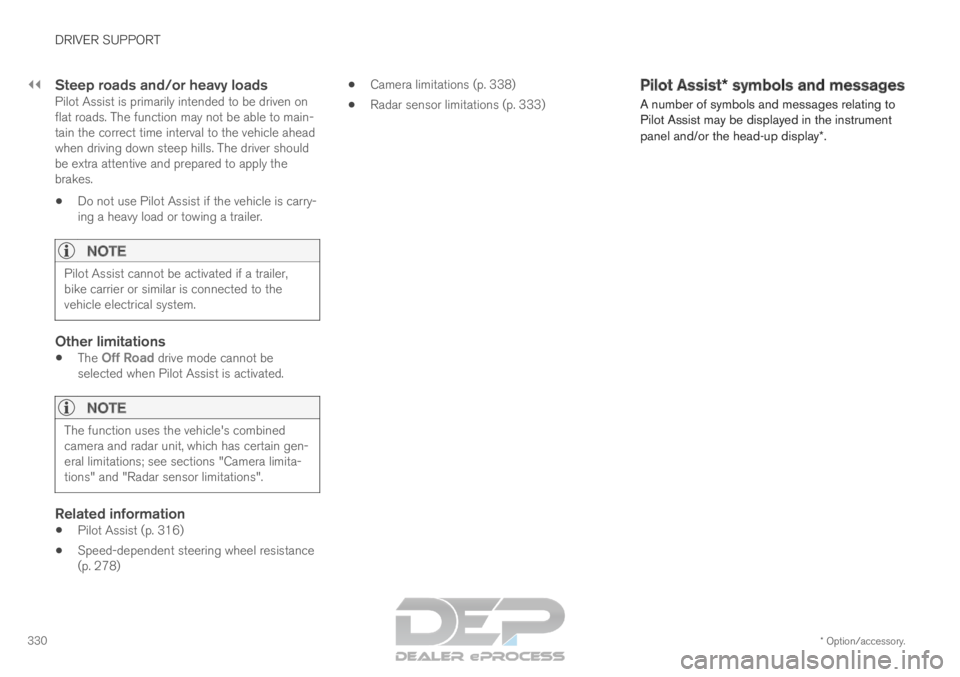
||DRIVER SUPPORT
* Option/accessory.
330
Steep roads and/or heavy loadsPilot Assist is primarily intended to be driven on
flat roads. The function may not be able to main-
tain the correct time interval to the vehicle ahead
when driving down steep hills. The driver should
be extra attentive and prepared to apply the
brakes.
Do not use Pilot Assist if the vehicle is carry-
ing a heavy load or towing a trailer.
NOTE Pilot Assist cannot be activated if a trailer,
bike carrier or similar is connected to the
vehicle electrical system.
Other limitations
The
Off Road drive mode cannot be
selected when Pilot Assist is activated.
NOTE The function uses the vehicle's combined
camera and radar unit, which has certain gen-
eral limitations; see sections "Camera limita-
tions" and "Radar sensor limitations".
Related information
Pilot Assist (p. 316)
Speed-dependent steering wheel resistance
(p. 278)
Camera limitations (p. 338)
Radar sensor limitations (p. 333) Pilot Assist* symbols and messages
A number of symbols and messages relating to
Pilot Assist may be displayed in the instrument
panel and/or the head-up display*.
Page 343 of 697
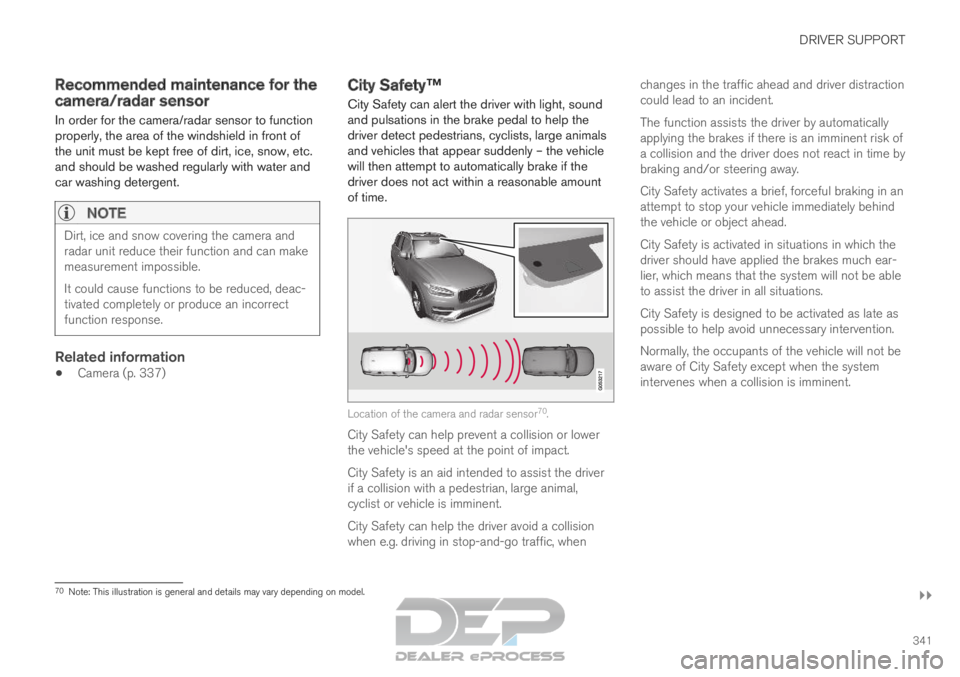
DRIVER SUPPORT
}}
341
Recommended maintenance for the
camera/radar sensor
In order for the camera/radar sensor to function
properly, the area of the windshield in front of
the unit must be kept free of dirt, ice, snow, etc.
and should be washed regularly with water and
car washing detergent.
NOTE Dirt, ice and snow covering the camera and
radar unit reduce their function and can make
measurement impossible.
It could cause functions to be reduced, deac-
tivated completely or produce an incorrect
function response.
Related information
Camera (p. 337) City Safety™
City Safety can alert the driver with light, sound
and pulsations in the brake pedal to help the
driver detect pedestrians, cyclists, large animals
and vehicles that appear suddenly – the vehicle
will then attempt to automatically brake if the
driver does not act within a reasonable amount
of time. Location of the camera and radar sensor
70
.
City Safety can help prevent a collision or lower
the vehicle's speed at the point of impact.
City Safety is an aid intended to assist the driver
if a collision with a pedestrian, large animal,
cyclist or vehicle is imminent.
City Safety can help the driver avoid a collision
when e.g. driving in stop-and-go traffic, when changes in the traffic ahead and driver distraction
could lead to an incident.
The function assists the driver by automatically
applying the brakes if there is an imminent risk of
a collision and the driver does not react in time by
braking and/or steering away.
City Safety activates a brief, forceful braking in an
attempt to stop your vehicle immediately behind
the vehicle or object ahead.
City Safety is activated in situations in which the
driver should have applied the brakes much ear-
lier, which means that the system will not be able
to assist the driver in all situations.
City Safety is designed to be activated as late as
possible to help avoid unnecessary intervention.
Normally, the occupants of the vehicle will not be
aware of City Safety except when the system
intervenes when a collision is imminent.
70
Note: This illustration is general and details may vary depending on mod\
el.
Page 345 of 697
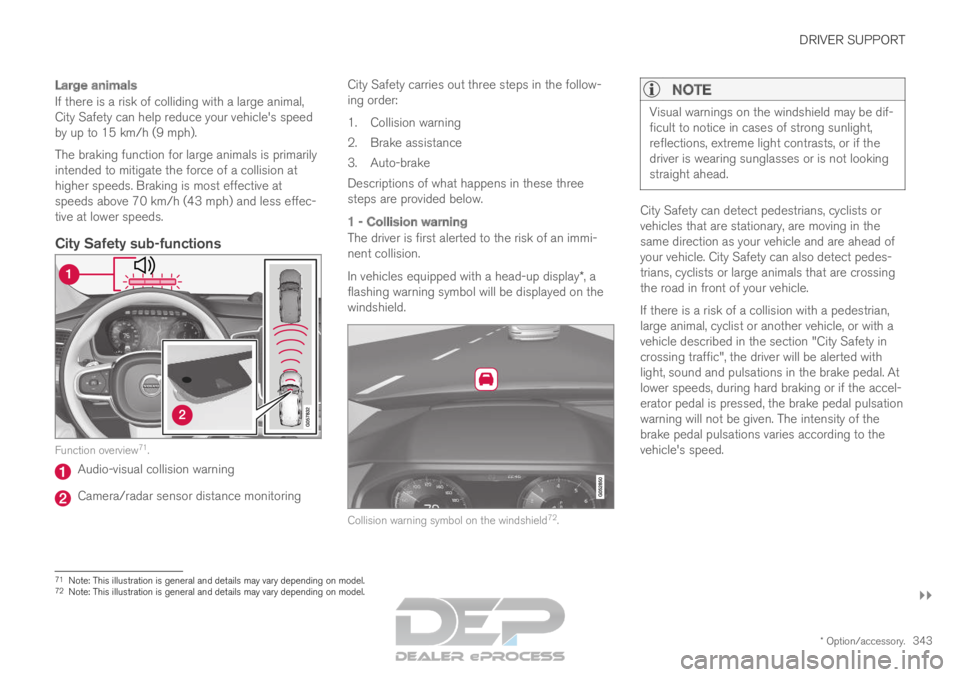
DRIVER SUPPORT
}}
* Option/accessory. 343
Large animals
If there is a risk of colliding with a large animal,
City Safety can help reduce your vehicle's speed
by up to 15 km/h (9 mph).
The braking function for large animals is primarily
intended to mitigate the force of a collision at
higher speeds. Braking is most effective at
speeds above 70 km/h (43 mph) and less effec-
tive at lower speeds.
City Safety sub-functionsFunction overview
71
. Audio-visual collision warning
Camera/radar sensor distance monitoring City Safety carries out three steps in the follow-
ing order:
1.
Collision warning
2. Brake assistance
3. Auto-brake
Descriptions of what happens in these three
steps are provided below.
1 - Collision warning
The driver is first alerted to the risk of an immi-
nent collision.
In vehicles equipped with a head-up display*, a
flashing warning symbol will be displayed on the
windshield. Collision warning symbol on the windshield
72
.
NOTE Visual warnings on the windshield may be dif-
ficult to notice in cases of strong sunlight,
reflections, extreme light contrasts, or if the
driver is wearing sunglasses or is not looking
straight ahead.
City Safety can detect pedestrians, cyclists or
vehicles that are stationary, are moving in the
same direction as your vehicle and are ahead of
your vehicle. City Safety can also detect pedes-
trians, cyclists or large animals that are crossing
the road in front of your vehicle.
If there is a risk of a collision with a pedestrian,
large animal, cyclist or another vehicle, or with a
vehicle described in the section "City Safety in
crossing traffic", the driver will be alerted with
light, sound and pulsations in the brake pedal. At
lower speeds, during hard braking or if the accel-
erator pedal is pressed, the brake pedal pulsation
warning will not be given. The intensity of the
brake pedal pulsations varies according to the
vehicle's speed.
71
Note: This illustration is general and details may vary depending on mod\
el.
72 Note: This illustration is general and details may vary depending on mod\
el.
Page 350 of 697
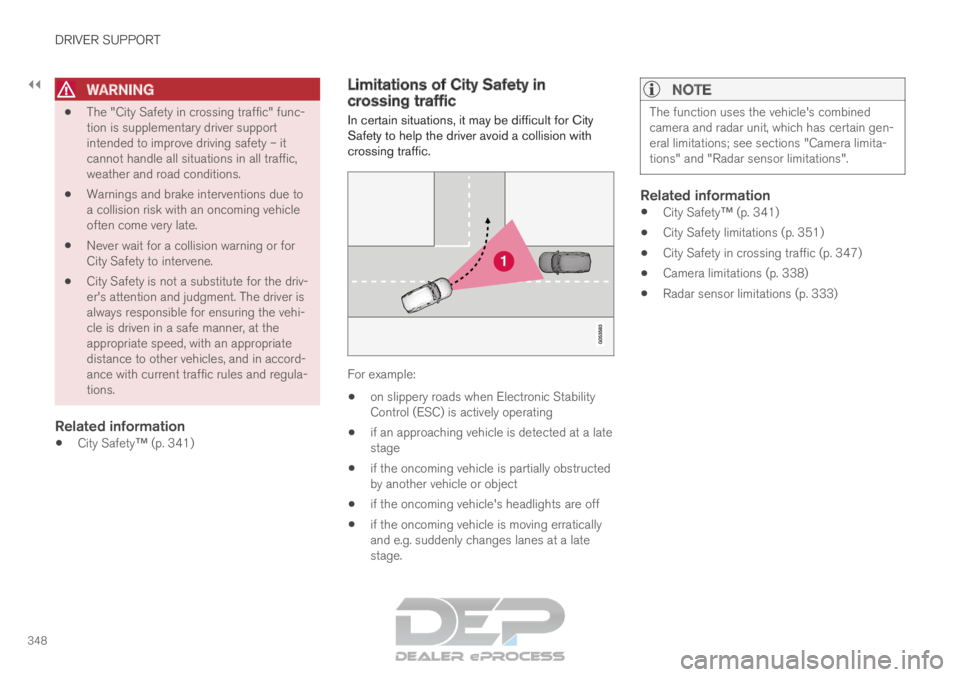
||DRIVER SUPPORT
348
WARNING
The "City Safety in crossing traffic" func-
tion is supplementary driver support
intended to improve driving safety – it
cannot handle all situations in all traffic,
weather and road conditions.
Warnings and brake interventions due to
a collision risk with an oncoming vehicle
often come very late.
Never wait for a collision warning or for
City Safety to intervene.
City Safety is not a substitute for the driv-
er's attention and judgment. The driver is
always responsible for ensuring the vehi-
cle is driven in a safe manner, at the
appropriate speed, with an appropriate
distance to other vehicles, and in accord-
ance with current traffic rules and regula-
tions.
Related information
City Safety™ (p. 341) Limitations of City Safety in
crossing traffic
In certain situations, it may be difficult for City
Safety to help the driver avoid a collision with
crossing traffic. For example:
on slippery roads when Electronic Stability
Control (ESC) is actively operating
if an approaching vehicle is detected at a late
stage
if the oncoming vehicle is partially obstructed
by another vehicle or object
if the oncoming vehicle's headlights are off
if the oncoming vehicle is moving erratically
and e.g. suddenly changes lanes at a late
stage.
NOTE The function uses the vehicle's combined
camera and radar unit, which has certain gen-
eral limitations; see sections "Camera limita-
tions" and "Radar sensor limitations".
Related information
City Safety™ (p. 341)
City Safety limitations (p. 351)
City Safety in crossing traffic (p. 347)
Camera limitations (p. 338)
Radar sensor limitations (p. 333)
Page 351 of 697

DRIVER SUPPORT
349
City Safety and delayed evasive
maneuvers
City Safety can assist the driver by automatically
braking the vehicle when it is not possible to
avoid a collision by steering alone.
City Safety assists the driver by periodically
attempting to predict possible "escape routes" to
the sides of the vehicle in the event a slow-mov-
ing or stationary vehicle were to be detected at a
late stage.
Your vehicle (1) cannot detect any potential escape
routes for veering away from the vehicle ahead (2) and
may therefore apply the brakes at an earlier stage.
Own vehicle
Slow-moving/stationary vehicles
City Safety will not intervene to automatically
apply the brakes if it is possible for the driver to
avoid a collision by steering the vehicle. However, if City Safety determines that an eva-
sive maneuver would not be possible due to traf-
fic in the adjacent lane(s), the function can assist
the driver by automatically starting to apply the
brakes at an earlier stage.
WARNING
The possibility of City Safety predicting a
certain situation is supplementary driver
support intended to improve driving safety
– it cannot handle all situations in all traf-
fic, weather and road conditions.
City Safety is not a substitute for the driv-
er's attention and judgment. The driver is
always responsible for ensuring the vehi-
cle is driven in a safe manner, at the
appropriate speed, with an appropriate
distance to other vehicles, and in accord-
ance with current traffic rules and regula-
tions.
Limitations of City Safety during evasive
maneuvers
NOTE The function uses the vehicle's combined
camera and radar unit, which has certain gen-
eral limitations; see sections "Camera limita-
tions" and "Radar sensor limitations".
Related information
City Safety™ (p. 341)
Camera limitations (p. 338)
Radar sensor limitations (p. 333)
Page 352 of 697
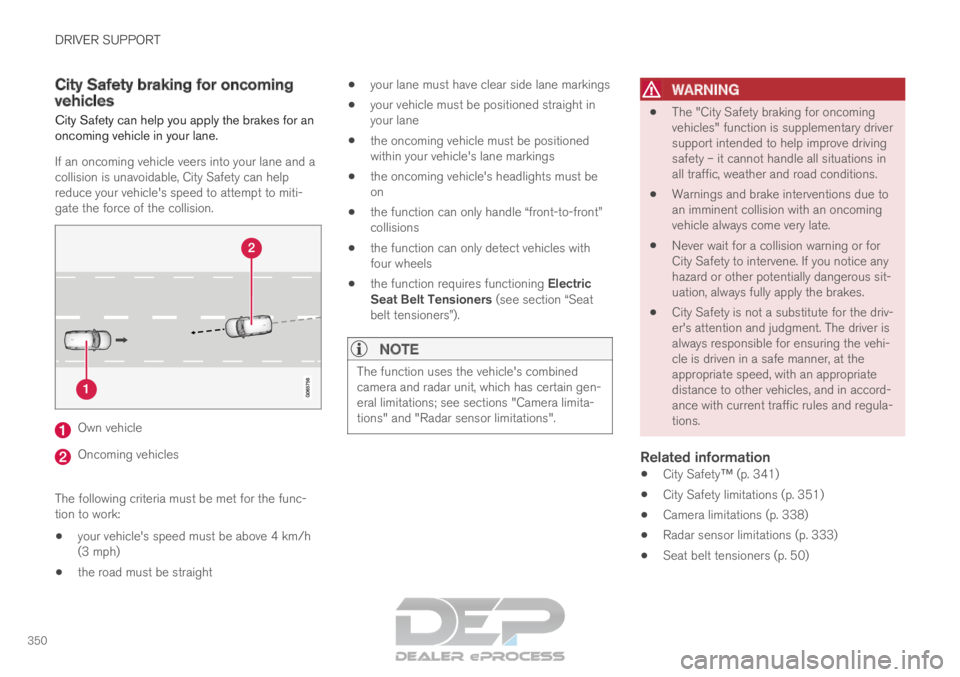
DRIVER SUPPORT
350City Safety braking for oncoming
vehicles
City Safety can help you apply the brakes for an
oncoming vehicle in your lane.
If an oncoming vehicle veers into your lane and a
collision is unavoidable, City Safety can help
reduce your vehicle's speed to attempt to miti-
gate the force of the collision. Own vehicle
Oncoming vehicles
The following criteria must be met for the func-
tion to work:
your vehicle's speed must be above 4 km/h
(3 mph)
the road must be straight
your lane must have clear side lane markings
your vehicle must be positioned straight in
your lane
the oncoming vehicle must be positioned
within your vehicle's lane markings
the oncoming vehicle's headlights must be
on
the function can only handle “front-to-front”
collisions
the function can only detect vehicles with
four wheels
the function requires functioning Electric
Seat Belt Tensioners (see section “Seat
belt tensioners”).
NOTE The function uses the vehicle's combined
camera and radar unit, which has certain gen-
eral limitations; see sections "Camera limita-
tions" and "Radar sensor limitations".
WARNING
The "City Safety braking for oncoming
vehicles" function is supplementary driver
support intended to help improve driving
safety – it cannot handle all situations in
all traffic, weather and road conditions.
Warnings and brake interventions due to
an imminent collision with an oncoming
vehicle always come very late.
Never wait for a collision warning or for
City Safety to intervene. If you notice any
hazard or other potentially dangerous sit-
uation, always fully apply the brakes.
City Safety is not a substitute for the driv-
er's attention and judgment. The driver is
always responsible for ensuring the vehi-
cle is driven in a safe manner, at the
appropriate speed, with an appropriate
distance to other vehicles, and in accord-
ance with current traffic rules and regula-
tions.
Related information
City Safety™ (p. 341)
City Safety limitations (p. 351)
Camera limitations (p. 338)
Radar sensor limitations (p. 333)
Seat belt tensioners (p. 50)
Page 354 of 697

||DRIVER SUPPORT
352
Other limitations
WARNING
Warnings and brake interventions can be
triggered late or not at all if the traffic sit-
uation or external influences prevent the
camera and radar unit from properly
detecting pedestrians, cyclists, large ani-
mals or vehicles ahead of the vehicle.
To be able to detect vehicles at night, its
front and rear lights must work and illumi-
nate clearly.
The camera and radar unit have a limited
range for pedestrians and cyclists – the
system can provide effective warnings
and brake interventions if the relative
speed is lower than 50 km/h (30 mph).
For stationary or slow-moving vehicles,
warnings and brake interventions are
effective at vehicle speeds of up to
70 km/h (43 mph). Speed reduction for
large animals is less than 15 km/h
(9 mph) and can be achieved at vehicle
speeds over 70 km/h (43 mph). At lower
speeds, the warning and brake interven-
tion for large animals is less effective.
Warnings for stationary or slow-moving
vehicles and large animals can be disen-
gaged due to darkness or poor visibility.
Warnings and brake interventions for
pedestrians and cyclists are disengaged
at vehicle speeds over 80 km/h
(50 mph).
Do not place, affix or mount anything on
the inside or outside of the windshield, or
in front of or around the camera and
radar unit – this could disrupt camera-
based functions.
Objects, snow, ice or dirt in the area of
the camera sensor can reduce the func-
tion, disengage it completely or give an
improper function response.
NOTE The function uses the vehicle's combined
camera and radar unit, which has certain gen-
eral limitations; see sections "Camera limita-
tions" and "Radar sensor limitations".
Market limitationsCity Safety is not available in all countries. If City
Safety is not shown in the center display's
Settings menu, your vehicle is not equipped with
this function.
In the center display's Top view, tap:
Settings My Car IntelliSafe
Related information
City Safety™ (p. 341)
Camera limitations (p. 338)
Radar sensor limitations (p. 333)